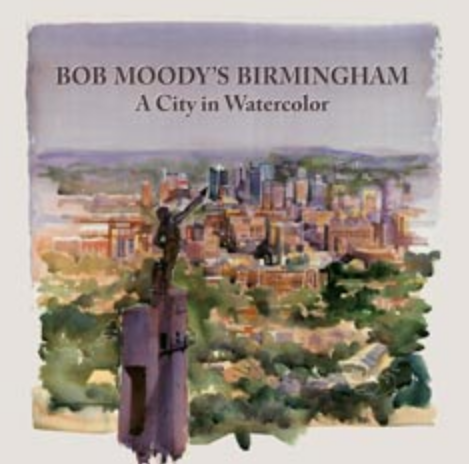(Click image to purchase from Amazon)
Bob Moody’s Birmingham: A City in Watercolor
If anyone can make Birmingham even more beautiful, even richer in texture, and elegant in design, it’s watercolorist Bob Moody, whose newest volume, Bob Moody’s Birmingham–A City in Watercolor, is one of the most celebrated publications of the Birmingham Historical Society (BHS).
“Through a decades-long romance with our city, Bob has come to know buildings personally, as if they were beings with feelings and flair,” says Marjorie White, BHS director. “The result of his talent meeting the classic nature of Birmingham is a book that will surely be passed down through generations to come. It’s that special.”
Produced on rich Japanese art paper, the sort that feels as lush as the works themselves, Bob Moody’s Birmingham offers 107 watercolors in full color. For its cover, Moody stood behind Vulcan, peering out at the expanse of city below just as our famous icon does himself. This overview sets the tone for what awaits inside: Moody’s subjects range from a 1967 view of Terminal Station to Sloss Furnaces, Morris Avenue’s Peanut Depot, the Lyric Theatre, 16th Street Baptist Church, Oak Hill Cemetery, Dreamland, Bogue’s, English Village, Mountain Brook’s Old Mill, and so many more. Each image invites a swirl of memories and bursts of pride for today’s Birmingham.
“Photographs of our buildings are one thing; Bob Moody’s treatments are yet another,” says White. “He paints skillfully with watercolors, yes, but the extra ingredient is the love he feels for each site. They are whispers of the relationship he’s had with Birmingham since he first visited in the 1940s–a relationship that, if anything, has grown even stronger since that first flirtation.”
Bob Moody, a native of Boaz, Alabama, incorporated his watercolor abilities into his long career as a commercial interior designer, establishing the Moody & Associates design firm in 1974. Beyond that active practice, he and wife Rebecca not only appreciated Birmingham’s architecture; they began to purchase buildings. (One of their first tenants was Frank Stitt, “a young man with passion and energy from Cullman, Alabama,” who quickly became the highly lauded chef/ restauranteur known internationally today.)

